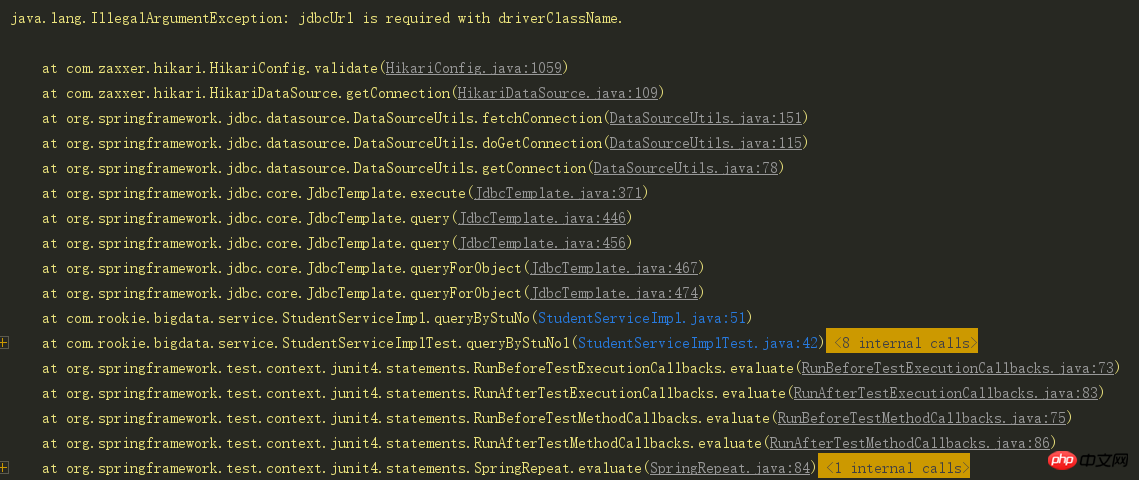
The content of this article is about springboot's method of configuring JdbcTemplate using multiple data sources. It has certain reference value. Friends in need can refer to it. I hope it will be helpful to you.
springboot multiple data source configuration, the code is as follows
DataSourceConfig
package com.rookie.bigdata.config; import org.springframework.beans.factory.annotation.Qualifier; import org.springframework.boot.context.properties.ConfigurationProperties; import org.springframework.boot.jdbc.DataSourceBuilder; import org.springframework.context.annotation.Bean; import org.springframework.context.annotation.Configuration; import org.springframework.context.annotation.Primary; import org.springframework.jdbc.core.JdbcTemplate; import javax.sql.DataSource; /** * @author * @date 2018/10/10 */ @Configuration public class DataSourceConfig { @Bean(name = "primaryDataSource") @Qualifier("primaryDataSource") @ConfigurationProperties(prefix="spring.datasource.primary") public DataSource primaryDataSource() { return DataSourceBuilder.create().build(); } @Bean(name = "secondaryDataSource") @Qualifier("secondaryDataSource") @Primary @ConfigurationProperties(prefix="spring.datasource.secondary") public DataSource secondaryDataSource() { return DataSourceBuilder.create().build(); } @Bean(name = "primaryJdbcTemplate") public JdbcTemplate primaryJdbcTemplate( @Qualifier("primaryDataSource") DataSource dataSource) { return new JdbcTemplate(dataSource); } @Bean(name = "secondaryJdbcTemplate") public JdbcTemplate secondaryJdbcTemplate( @Qualifier("secondaryDataSource") DataSource dataSource) { return new JdbcTemplate(dataSource); } }
StudentServiceImpl
package com.rookie.bigdata.service; import com.rookie.bigdata.domain.Student; import org.springframework.beans.factory.annotation.Autowired; import org.springframework.beans.factory.annotation.Qualifier; import org.springframework.jdbc.core.JdbcTemplate; import org.springframework.stereotype.Service; /** * @author * @date 2018/10/9 */ @Service public class StudentServiceImpl implements StudentService { @Autowired @Qualifier("primaryJdbcTemplate") private JdbcTemplate jdbcTemplate; @Autowired @Qualifier("secondaryJdbcTemplate") private JdbcTemplate jdbcTemplate2; /** * 采用第一个暑假源进行插入数据 * @param student */ @Override public void create(Student student) { jdbcTemplate.update("INSERT INTO student(stu_no,name,age)VALUE (?,?,?)", student.getStuNo(), student.getName(), student.getAge()); } /** * 第一个数据源进行插入数据 * @param stuNo */ @Override public void deleteByNo(Integer stuNo) { jdbcTemplate.update("DELETE FROM student WHERE stu_no=?", stuNo); } /** * 第二个数据源进行查询数据 * @param stuNo * @return */ @Override public Integer queryByStuNo(Integer stuNo) { return jdbcTemplate2.queryForObject("select count(1) from student", Integer.class); } }
Configuration file application.properties
spring.datasource.primary.url=jdbc:mysql://localhost:3306/springboot spring.datasource.primary.username=root spring.datasource.primary.password=root spring.datasource.primary.driver-class-name=com.mysql.jdbc.Driver spring.datasource.secondary.url=jdbc:mysql://localhost:3306/springboot spring.datasource.secondary.username=root spring.datasource.secondary.password=root spring.datasource.secondary.driver-class-name=com.mysql.jdbc.Driver
The test code is as follows
package com.rookie.bigdata.service; import com.rookie.bigdata.domain.Student; import org.junit.Test; import org.junit.runner.RunWith; import org.springframework.beans.factory.annotation.Autowired; import org.springframework.boot.test.context.SpringBootTest; import org.springframework.test.context.junit4.SpringRunner; /** * @author liuxili * @date 2018/10/10 */ @RunWith(SpringRunner.class) @SpringBootTest public class StudentServiceImplTest { @Autowired private StudentServiceImpl studentService; @Test public void create1() throws Exception { Student student = new Student(); student.setStuNo(1L); student.setName("张三"); student.setAge(23); studentService.create(student); } @Test public void deleteByName1() throws Exception { studentService.deleteByNo(1); } @Test public void queryByStuNo1() throws Exception { System.out.println(studentService.queryByStuNo(1)); } }
The following exception will occur during operation. The operation fails and java.lang.IllegalArgumentException is reported: jdbcUrl is required with driverClassName.Exception

After checking the information, I found that the reason for this problem is due to the springboot version. The springboot version used in this example is 2.0.5. If the version is changed to a version before 1.5, it will not work. The above problems will occur. In fact, there are two main solutions to solve the above exceptions.
Solution 1:
Modify the application.properties configuration file according to the following scheme, as follows: After the modification is completed, The above exception will not occur again
spring.datasource.primary.jdbc-url=jdbc:mysql://localhost:3306/springboot spring.datasource.primary.username=root spring.datasource.primary.password=root spring.datasource.primary.driver-class-name=com.mysql.jdbc.Driver spring.datasource.secondary.jdbc-url=jdbc:mysql://localhost:3306/springboot spring.datasource.secondary.username=root spring.datasource.secondary.password=root spring.datasource.secondary.driver-class-name=com.mysql.jdbc.Driver
Option 2:
Do not modify the original application.properties configuration file, modify the information in the DataSourceConfig class, as follows: After the modification is completed, the exception will It will no longer appear that it can run normally
application.properties
spring.datasource.primary.url=jdbc:mysql://localhost:3306/springboot spring.datasource.primary.username=root spring.datasource.primary.password=root spring.datasource.primary.driver-class-name=com.mysql.jdbc.Driver spring.datasource.secondary.url=jdbc:mysql://localhost:3306/springboot spring.datasource.secondary.username=root spring.datasource.secondary.password=root spring.datasource.secondary.driver-class-name=com.mysql.jdbc.Driver
DataSourceConfig
package com.rookie.bigdata.config; import org.springframework.beans.factory.annotation.Qualifier; import org.springframework.boot.autoconfigure.jdbc.DataSourceProperties; import org.springframework.boot.context.properties.ConfigurationProperties; import org.springframework.context.annotation.Bean; import org.springframework.context.annotation.Configuration; import org.springframework.context.annotation.Primary; import org.springframework.jdbc.core.JdbcTemplate; import javax.sql.DataSource; /** * @author * @date 2018/10/10 */ @Configuration public class DataSourceConfig { @Bean(name = "primaryJdbcTemplate") public JdbcTemplate primaryJdbcTemplate( @Qualifier("primaryDataSource") DataSource dataSource) { return new JdbcTemplate(dataSource); } @Bean(name = "secondaryJdbcTemplate") public JdbcTemplate secondaryJdbcTemplate( @Qualifier("primaryDataSource") DataSource dataSource) { return new JdbcTemplate(dataSource); } @Primary @Bean(name = "primaryDataSourceProperties") @Qualifier("primaryDataSourceProperties") @ConfigurationProperties(prefix = "spring.datasource.primary") public DataSourceProperties primaryDataSourceProperties() { return new DataSourceProperties(); } @Bean(name = "secondaryDataSourceProperties") @Qualifier("secondaryDataSourceProperties") @ConfigurationProperties(prefix = "spring.datasource.secondary") public DataSourceProperties secondaryDataSourceProperties() { return new DataSourceProperties(); } @Primary @Bean(name = "primaryDataSource") @Qualifier("primaryDataSource") @ConfigurationProperties(prefix = "spring.datasource.primary") public DataSource primaryDataSource() { return primaryDataSourceProperties().initializeDataSourceBuilder().build(); } @Bean(name = "secondaryDataSource") @Qualifier("secondaryDataSource") @ConfigurationProperties(prefix = "spring.datasource.secondary") public DataSource secondaryDataSource() { return primaryDataSourceProperties().initializeDataSourceBuilder().build(); } }
At this point, springboot uses multiple data sources to configure JdbcTemplate and has a perfect solution
The above is the detailed content of Springboot uses multiple data sources to configure JdbcTemplate. For more information, please follow other related articles on the PHP Chinese website!